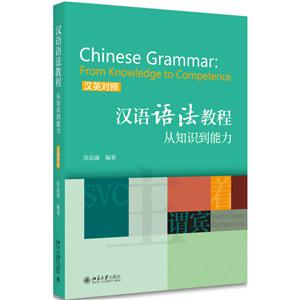-
>
考研英語背單詞20個詞根詞綴
-
>
西班牙語詞根寶典
-
>
美國K-12原版語文課本--初中·下(全12冊)
-
>
流浪地球劉慈欣
-
>
西南聯大英文課 輕讀禮盒版
-
>
英語大書蟲世界經典名譯典藏書系:中國人的精神 (英漢對照)(精選權威版本)
-
>
許淵沖譯唐詩三百首:漢文·英語
漢語語法教程從知識到能力-漢英對照 版權信息
- ISBN:9787301282588
- 條形碼:9787301282588 ; 978-7-301-28258-8
- 裝幀:暫無
- 冊數:暫無
- 重量:暫無
- 所屬分類:>>
漢語語法教程從知識到能力-漢英對照 本書特色
這是為以漢語作為第二語言的中高級學習者編寫的實用語法教材。《漢語語法教程:從知識到能力(漢英對照)》打破了理論語法的框架,從幫助學習者了解漢語句子的基本結構、提高語法能力的角度出發,安排相關的語言項目,共20講,分為上、下兩編。上編12講主要講述與句子主要成分相關的語法,下編8講主要講述時體、情態范疇的語法。每講都依據知識點的內在邏輯進行了分解處理,層層遞進,中英文對照,并輔以大量活潑有趣的針對性練習。該教材力求引導學習者自我發現語法規律,在有意義的交際語境中關注語法形式。
同時,這也是一本語法教學的參考書,凝聚了編者十多年的語法教學積累。年輕的新手教師和漢語國際教育專業的研究生可以從中了解漢語作為第二語言教學的基本語法項目的相關教學知識,感受完整的語法教學設計和教學方法,了解學習者語法學習的常見偏誤。通過掃描書里的二維碼,更能直觀地看到編者的語法教學實況視頻和教案,理解本書獨特的編寫理念,輕松上手漢語作為第二語言的語法教學。
漢語語法教程從知識到能力-漢英對照 內容簡介
《漢語語法教程:從知識到能力(漢英對照)》正如其名,以漢語語法知識為出發點,以漢語語法的應用能力為落腳點。編者在北京大學多年開設留學生語法專題課,書里的很多問題都是別人沒有講過的。所有的語法知識都進行了分解處理,中英文對照講解,加上鮮活的針對性練習,即講即練,節奏感強,學習者很容易實現語法學習的成就感,體會到駕馭語法后用漢語自由表達的樂趣。
漢語語法教程從知識到能力-漢英對照 目錄
引言Introduction / 1
上編 Part One
**講 漢語語法的特點
The Distinguishing Features of Chinese Grammar 4
1.1 漢語語法的特點一
The first distinguishing feature of Chinese grammar / 4
1.2 漢語語法的特點二
The second distinguishing feature of Chinese grammar / 6
1.3 漢語語法的特點三
The third distinguishing feature of Chinese grammar / 7
1.4 句子結構與“的、地、得” Sentence structure and “的, 地, 得” / 9
第二講 時點詞與時量詞 Time Words 18
2.1 時點詞Time-when words / 19
2.2 時量詞 Time-duration words / 21
2.3 幾組時間詞的用法 Usage of several groups of time words / 29
第三講 方位詞與處所表達
Nouns of Locality and Expressing Place 40
3.1 方位詞 Nouns of locality / 42
3.2 用不用方位詞“里”或“上”
Can nouns of locality “里” or “上” be used / 45
3.3 “在、是、有”與存在句 “在,是,有” and existential sentences / 49
3.4 在……上、在……中、在……下 / 50
第四講 離合詞 Verb-Object Compounds 57
4.1 離合詞引進賓語的辦法 V-O compounds and their “objects” / 58
4.2 離合詞的用法 Usage of verb-object compounds / 61
第五講 結果補語 Resultative Complements 65
5.1 結果補語的形式 The form of resultative complements / 66
5.2 結果補語的意義 The meaning of resultative complements / 69
5.3 專用結果補語 Special resultative complements / 71
5.4 結果補語的用法 Usage of resultative complements / 80
第六講 趨向補語 Directional Complements 86
6.1 趨向補語的類型 Types of directional complements / 88
6.2 趨向補語的用法 Usage of directional complements / 91
第七講 可能補語 Potential Complements 103
7.1 可能補語的形式 The form of potential complements / 104
7.2 專用可能補語 Special potential complements / 105
7.3 可能補語與“ (不)能”
Potential complements and “ (不)能” / 108
第八講 狀態補語 Predicative Complements 112
8.1 狀態補語 V得AP / 113
8.2 狀態補語 V得VP / 118
8.3 狀態補語 A得 VP / 120
8.4 狀態補語的用法 Usage of predicative complements / 121
8.5 狀態補語與可能補語
Predicative complements and potential complements / 124
8.6 補語總結 Summary of complements / 126
第九講 “把”字句 把-Sentences 132
9.1 句子的信息安排與“把”字句
The ordering of information and 把-sentences / 132
9.2 關于“把”字句的注意事項
Special considerations concerning 把-sentences / 136
9.3 幾種主要的“把”字句
Several primary types of 把-sentences / 137
第十講 被動句 Passive Sentences 153
10.1 “被”字句 被-sentences / 153
10.2 主要的“被”字句句型
The primary sentence patterns of 被-sentences / 157
10.3 其他的被動句 Other passive sentence patterns / 159
第十一講 定語 Attributives 165
11.1 領屬關系NP中,名詞性定語與“的”
Attributive noun and “的” in relative nominal phrases / 166
11.2 屬性關系NP中,名詞性定語與“的”
Attributive noun and “的”in NP of attribution relations / 167
11.3 時間詞、處所詞、方位詞與“的”
Time words, place words, nouns of locality and “的” / 168
11.4 形容詞性定語與“的” Adjectival attributives and “的” / 169
11.5 動詞性定語與“的” Verbal attributives and “的” / 172
11.6 介詞短語定語與“的”
Prepositional phrase attributives and “的” / 174
11.7 數量詞定語與“的”Numeral-classifier attributives and “的” / 174
11.8 多項定語 Multiple attributives / 182
第十二講 狀語 Adverbials 196
12.1 狀語的類型 Types of adverbials / 196
12.2 介詞短語狀語與“地”
Prepositional phrase adverbials and “地” / 198
12.3 形容詞狀語與“地” Adjectival adverbials and “地” / 199
12.4 數量詞狀語與“地”
Numeral-classifier adverbials and “地” / 203
12.5 副詞狀語與“地” Adverb as adverbial and “地” / 205
12.6 多項狀語的順序 Word order of multiple adverbials / 206
12.7 狀語與補語 Adverbials and complements / 209
第十三講 要 會 將 220
13.1 要 / 221
13.2 會 / 225
13.3 將 / 227
13.4 S [未來時點詞] VP / 230
第十四講 在 正 呢 235
14.1 S 在 place V (O) / 236
14.2 S 正在 V( O) / 237
14.3 S 一直在 V( O) / 239
14.4 S 總在 V( O) / 240
14.5 S (正/一直/總)在 V (O) 呢 / 241
第十五講 著 244
15.1 “在”與“著” / 244
15.2 (正) V1著(O) V2(O) / 247
15.3 “ (正)急著 V”與“ (正/在)忙著 V” / 249
15.4 S (正)在 place V1著(O) V2(O)
S V1在 place V2(O) / 250
15.5 處所 V著 O / 251
15.6 V1著V1著 V2 / 254
15.7 V著 / 256
15.8“著”與“呢” / 257
第十六講 了 265
16.1 “了1”和“了2”的意義
The meaning of “了1”and“了2” / 266
16.2“了2”的意義和用法 The meaning and usage of “了2” / 269
16.3“了1”的意義和用法 The meaning and usage of “了1” / 275
16.4 敘事語篇里的“了2”與“了1”
“了2” and “了1”in narrative discourse / 277
16.5 “了1”的注意事項
Special considerations concerning “了1” / 284
第十七講 過 來著 是……的 不 沒 291
17.1 過 / 291
17.2 來著 / 295
17.3 是……的 / 296
17.4“沒”與“不” / 299
第十八講 V起來 V下去 307
18.1 V起來 / 307
18.2 V下去 / 310
第十九講 動詞重疊 Verb Reduplications 317
19.1動詞重疊的形式The form of verb reduplication / 317
19.2 動詞重疊的意義 The meaning of reduplication verbs / 318
19.3 動詞重疊的用法 Usage of reduplication verbs / 319
第二十講 語氣助詞 Modal Particles 329
20.1 疑問句與“嗎、呢、吧、啊”
Interrogative sentences and “嗎, 呢, 吧, 啊” / 330
20.2感嘆句與“啊”Exclamatory sentences and “啊” / 338
20.3 祈使句與“吧、啊、嘛、唄”
Imperative sentences and “吧, 啊, 嘛, 唄” / 342
20.4 陳述句與“呢、吧、啊、嘛、唄”
Declarative sentences and “呢, 吧, 啊, 嘛, 唄” / 347
20.5 語氣助詞用法總結 Summary of modal particle usage / 366
參考答案 Answer Key 374
主要參考文獻 Main References 446
致謝 Acknowledgements 448
漢語語法教程從知識到能力-漢英對照 作者簡介
徐晶凝,北京大學對外漢語教育學院教授,研究生教研室主任。研究領域為漢語語言學理論與對外漢語教學語法,尤其關注情態和時體、語篇問題。在北京大學多年開設中級漢語語法課及相關的慕課課程,受到學生們的普遍好評,多次承擔國家漢辦等組織的國內外漢語師資培訓項目。
- >
新文學天穹兩巨星--魯迅與胡適/紅燭學術叢書(紅燭學術叢書)
- >
有舍有得是人生
- >
經典常談
- >
【精裝繪本】畫給孩子的中國神話
- >
我從未如此眷戀人間
- >
苦雨齋序跋文-周作人自編集
- >
巴金-再思錄
- >
中國歷史的瞬間















